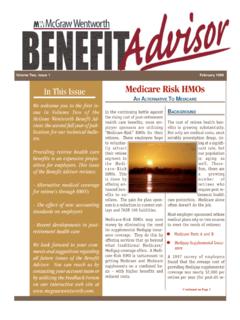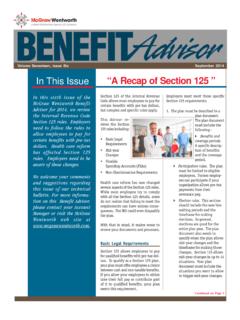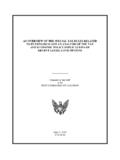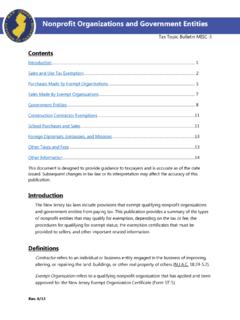Transcription of INTERNAL REVENUE CODE SECTION 79 - MMA …
1 INTERNAL REVENUE CODESECTION 79We welcome your commentsand suggestions regarding thisissue of our Benefit more information, pleasecontact your Account Manageror visit our website on Page 2 Volume Eighteen, Issue SixNovember 2015 WORLD CLASS. LOCAL 79 of the InternalRevenue code details the taximplications for employer-spon-sored group term life employees may have to paytaxes on the value of the followingtypes of employer-sponsoredgroup term life insurance: Employer-paid group term lifebenefits that exceed $50,000 Discriminatory employer-paidterm life plans Employer-sponsored voluntarylife coverage Employer-sponsored voluntarylife insurance paid for with pre-tax dollars under a SECTION 125planThis Advisor clarifies the keySection 79 areas to review at theend of each calendar year. Eachsection details potential taxconsequences for each sections will explain how tocalculate tax IMPLICATIONS FORNON-DISCRIMINATORYEMPLOYER-PAID LIFEINSURANCE COVERAGE THATEXCEEDS $50,000Up to $50,000 of employer-paidterm life insurance coverage istax-exempt under SECTION 79, solong as the plan does not favorkey employees.
2 To decidewhether this part of SECTION 79affects your employees, you willneed to review your plan todetermine whether it is consideredan employer-paid group termlife insurance plan. If your organi-zation pays the employee s entirelife coverage premium, the cover-age amount qualifies as employerpaid. Some employers pay forbase coverage, but allow employ-ees to pay for additional lifeinsurance. This SECTION appliesonly to the employer-paid 79 defines a group ofemployees as: All employees or a controlledgroup of Eighteen, Issue Six November 2015, Page 2 Continued on Page 3 Employees considered to bein a covered group because ofone of the following factors: Age (subject to ADEA requirements). Employment-relatedfactors, including unionmembership, job duties,length of employment,compensation or participa-tion in a company retire-ment, stock, bonus orgroup insurance the employer-paid group termlife coverage is $50,000 or less,then your employees should nothave to pay tax on the insurancevalue (a discriminatory plan mayhave tax consequences; see thenext SECTION ).
3 If you providemore than $50,000 in coverage,your organization will probablyhave to include the value of theexcess amount only in youraffected employees the following three circum-stances, even if the coveragevalue exceeds $50,000, you arenot required to include the valuein the employee s gross income:1. If a terminated employee isconsidered disabled underSection 72(m)(7) of theInternal REVENUE order to qualify for thisexception, employees mustsubmit proof of disability withtheir tax returns for the firstyear of disability, and proof ofcontinuing impairment forsubsequent If an employee names acharitable organization, asdefined under SECTION 170(c),as the sole beneficiary of allor part of life insuranceproceeds. The charitableorganization must be thenamed beneficiary for theentire plan year. This excep-tion also applies if the em-ployer is named the benefi-ciary of the If your plan existed on January1, 1984, and the life benefit isfor a covered employee whoretired before January 2, retiree also must haveturned 55 before January 2,1984, and have beenemployed by your organizationor its than in these cases,employees or former employeeswill have to pay taxes on thevalue of employer-provided lifeinsurance exceeding $50, THE TAXCONSEQUENCESE mployer-Paid Group Term LifeCoverage that Exceeds $50,000 Follow the steps below to calcu-late the imputed income foremployees that have employer-paid life coverage that exceeds$50,000:Step 1:Determine employee slife this example, let sassume you offer allemployees $100,000 2:Subtract $50,000 fromthe amount of the lifebenefit.
4 $100,000 - $50,000 =$50,000 Step 3: Divide the Step 2difference by 1,000.$50,000/$1,000 = 50 Step 4: Multiply the result fromStep 3 by the Table Irate below (based onthe employee s age atthe end of the calendaryear). This result is theemployee s monthlyimputed income. If theemployee in thisexample is 43 years old,imputed income is $5 amonth (50 x $ ).tekcarBegAelbaTIrePsetaRegarevoCfo000, 1$ $ $ $ $ $ $ $ $ $ $ $TABLE I RATES PER $1,000 OF COVERAGEV olume Eighteen, Issue Six November 2015, Page 3 Continued on Page 4 Income can be reported for eachpaycheck, quarterly or evenannually. However, imputedincome must be reported at leastonce a year, and is subject toFICA IMPLICATIONS FORDISCRIMINATORY EMPLOYER-PAID LIFE INSURANCE PLANSFor the $50,000 tax exemption toapply to key employees, yourorganization s term life plan mustmeet the SECTION 79 non-discrimi-nation 79 does not allow plans tofavor key employees in eithereligibility or benefits. If your planfavors key employees, the valueof the entire amount of life insur-ance coverage that your organiza-tion provides becomes taxable forthose employees only.
5 Separatenon-discrimination tests considereligibility and first step in non-discrimina-tion testing should be to identifykey employeesunder your lifeinsurance box abovedescribesemployees thatfall into thatcategory. Youcan thenconduct theeligibility andbenefits test todetermine whether your planfavors these Eligibility TestThe benefits eligibility test deter-mines whether your plan favorskey employees based on theeligibility requirements for anemployer-paid group life plan. Agroup life plan is consideredA key employee is an employee who at any time during the plan year is:1. A more than 5 percent An employee owning more than a 1 percent interest in the companyand whose compensation or income from the employer exceeds$150,000 a An officer of the employer whose compensation exceeds $170,000for 2015 ($170,000 in 2016).WHO IS A KEY EMPLOYEE?discriminatory if it cannot meet atleast one of the following criteria:1. The plan benefits at least 70percent of all At least 85 percent of allparticipants are not consideredkey The plan covers a non-discriminatory class of employ-ees as determined by theInternal REVENUE Premiums are deducted pre-tax through a cafeteria planand the plan satisfies theSection 125 candisregard thefollowingemployeeswhen you aredeterminingwhether yourplan meets thenon-discrimi-nation requirements:1.
6 Anyone employed for lessthan three years2. Part-time or seasonalemployees3. Employees covered bya collective bargainingagreement between theemployer and union4. Non-resident aliens whoreceived no earned incomefrom the employerNon-discrimination standardsapply to current, disabled, formeror retired employees. You musttest life benefits for these classesseparately from current Amount TestGroup life plans cannot offer akey employee better benefits thanthey offer a non-key plan will automatically passthis test if either of the followingapplies: Your plan provides the sameamount of employer-paid lifeinsurance to all employees,such as a flat $20,000 lifebenefit to all employees Your plan determines thebenefit amount on apercentage of income anduses the same percentage ofearnings for all coveredemployees. For example, alleligible employees are coveredfor an amount equal to theirannual earningsVolume Eighteen, Issue Six November 2015, Page 4 Continued on Page 5 Even if a plan does not offer thesame coverage amount orpercentage for all employees, itstill might not necessarily favorkey employees.
7 If you offerdifferent benefits for differentclasses of employees, yourorganization must determinewhether each class can pass anyof the eligibility tests described inthe previous SECTION . The follow-ing example clarifies this point:ABC Company has 500employees and offers twoclasses of employer-paidgroup term life coverage. Itoffers all 400 of its hourlyemployees a life benefitequal to their annual earn-ings. At the same time, itoffers 100 salaried employ-ees a life benefit equal totwice their annual key employees arehourly, and 10 key employ-ees are salaried employeesmust meet benefits eligibilitystandards because thatbenefit class covers all keyemployees. Of the 100salaried participants, only 10are considered key employ-ees. Since fewer than 15percent of the salariedemployees are key employ-ees, this plan design wouldnot be considered discrimi-natory with the currentheadcounts. The benefitdesign passes the secondeligibility test described inthe previous SECTION : atleast 85 percent of allparticipants are not consid-ered key s assume ABC Com-pany adds a third class ofemployer-paid group termlife coverage.
8 The thirdclass is offered only to keyemployees. The benefitsequal three times annualearnings. This class wouldnot pass the benefits plan would be consid-ereddiscrimina-tory, andkey em-ployeeswould facetax reviewtheir life coverage annually tomake sure their plan doesn t favorkey THE TAXCONSEQUENCESP lans That Favor KeyEmployeesEmployers need to imputeadditional income on key employ-ees only when the life plan isconsidered the following when youcalculate this imputed income:1. Key employees do not get the$50,000 benefit exemption;you must calculate imputedincome based on the entireamount of their life You must use the greater ofTable I rates or the actual ratethe insurer charges when youcalculate imputed , the IRS does notclearly define the term actual general, you should not use thecomposite rate charged for eachthousand dollars of life determine a composite rate,your insurance carrier melds age-banded rates representing youremployee demographics.
9 You willneed to ask your life insurer forthe actual cost (or age-bandedrates) for your key employees. Itcould be argued that the actualcost can also take into accountany effectivediscounts thecarrier hasapplied to yourcomposite example, ifyour insurer givesyou a 15 percentdiscount on theannual compositerate, you couldapply that discount to the keyemployee s age rate before youdetermine the actual cost forimputed income TAX ISSUES FORVOLUNTARY EMPLOYEE-PAIDLIFE INSURANCE PLANSE mployers may need to calculateimputed income for employee-paid optional life plans. Imputedincome may apply in two in-stances with employee-paid your optional life insur-ance plan considered car-ried by the employer?Optional life plans are consid-ered employer-carried if theemployee-paid plan ratesstraddle the Table I rates inany given age your voluntary life agebands to determine whetheryou need to calculate imputedincome for certain your plan s optional life ratetable straddles Table I rates,you may need to add the costdifference to the affectedemployee s W-2.
10 This ruleapplies even if the employeeVolume Eighteen, Issue Six November 2015, Page 5 Continued on Page 6pays life premiums with after-tax your optional life ratetable to the Table I ratesshown in the chart on page all rate tiers are neithercompletely over norcompletely under Table I,then certain age bracketsbenefit more from theemployer-sponsored grouplife plan. You must imputeincome for the value of thecoverage for rate tiers thatfall below Table your employees pay forthe voluntary life coveragewith pre-tax dollars? If so,you must determine whetherimputedincome willapply to theirlife these twosituations, youwill need todetermineimputed income for employee-paid voluntary life , calculating the taxconsequence is different in THE TAXCONSEQUENCESV oluntary Life Rate TableStraddles Table ITo calculate imputed income foremployees who straddle theTable I rates, first identify theemployees who fall below theTable I rates. So long as thepremium deductions are takenwith after-tax dollars, the onlyemployees who will have imputedincome issues are those whoseage bands fall below Table this situation, you mustinclude both employer-paid andsupplemental life coverage whenyou determine each affectedemployee s SECTION 79 imputedincome.










